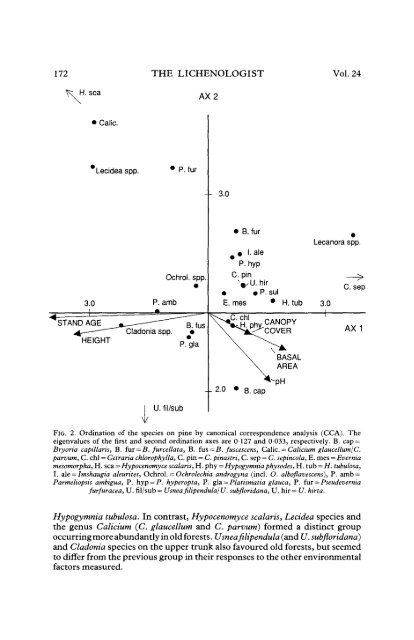Influence of Stand Age And Structure on the Epiphytic Lichen ...
Influence of Stand Age And Structure on the Epiphytic Lichen ...
Influence of Stand Age And Structure on the Epiphytic Lichen ...
Create successful ePaper yourself
Turn your PDF publications into a flip-book with our unique Google optimized e-Paper software.
172<br />
^r H. sea<br />
THE LICHENOLOGIST<br />
AX 2<br />
Vol. 24<br />
1 Calic.<br />
Lecidea spp.<br />
P. fur<br />
-- 3.0<br />
P. amb<br />
Ochrol. spp.<br />
• B. fur<br />
# - I. ale<br />
P. hyp<br />
C. pin<br />
VU. hir<br />
• • P. sul<br />
E. mes • H. tub<br />
Lecanora spp.<br />
3.0<br />
C. sep<br />
HEIGHT<br />
Clad<strong>on</strong>ia spp.<br />
B. fus<br />
P. gla<br />
JD. chl<br />
CANOPY<br />
COVER<br />
AX1<br />
BASAL<br />
AREA<br />
--2.0 • B. cap<br />
U. fil/sub<br />
FIG. 2. Ordinati<strong>on</strong> <str<strong>on</strong>g>of</str<strong>on</strong>g> <strong>the</strong> species <strong>on</strong> pine by can<strong>on</strong>ical corresp<strong>on</strong>dence analysis (CCA). The<br />
eigenvalues <str<strong>on</strong>g>of</str<strong>on</strong>g> <strong>the</strong> first and sec<strong>on</strong>d ordinati<strong>on</strong> axes are 0127 and 0033, respectively. B. cap =<br />
Bryoria capillaris, B. fur = B. furcellata, B. fus = B. fuscescens, Calic. = Calicium glaucellumlC.<br />
parvum, C. chl = Cetraria chlorophylla, C. pin = C. pinastri, C. sep = C. sepincola, E. mes = Evernia<br />
mesomorpha, H. sea = Hypocenomyce scalaris, H. phy = Hypogymnia physodes, H. tub = H. tubulosa,<br />
I. ale = Imshaugia aleurites, Ochrol. = Ochrolechia androgyna (incl. O. alb<str<strong>on</strong>g>of</str<strong>on</strong>g>lavescens), P. amb =<br />
Parmeliopsis ambigua, P. hyp = P. hyperopta, P. gla = Platismatia glauca, P. fur = Pseudevernia<br />
furfuracea, U. fil/sub = UsneafilipendulajU. subfloridana, U. hir= U. hirta.<br />
Hypogymnia tubulosa. In c<strong>on</strong>trast, Hypocenomyce scalaris, Lecidea species and<br />
<strong>the</strong> genus Calicium (C. glaucellum and C. parvum) formed a distinct group<br />
occurring more abundantly in old forests. Usneafilipendula (and U. subftoridana)<br />
and Clad<strong>on</strong>ia species <strong>on</strong> <strong>the</strong> upper trunk also favoured old forests, but seemed<br />
to differ from <strong>the</strong> previous group in <strong>the</strong>ir resp<strong>on</strong>ses to <strong>the</strong> o<strong>the</strong>r envir<strong>on</strong>mental<br />
factors measured.
















